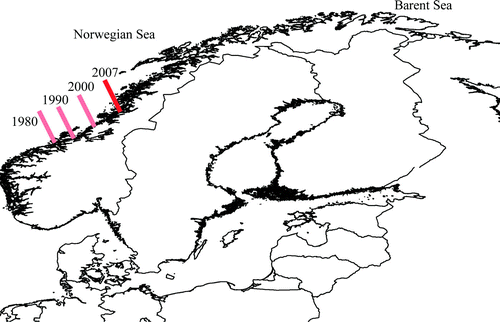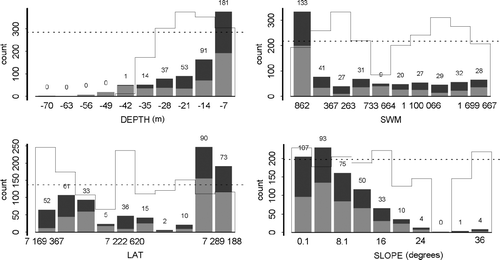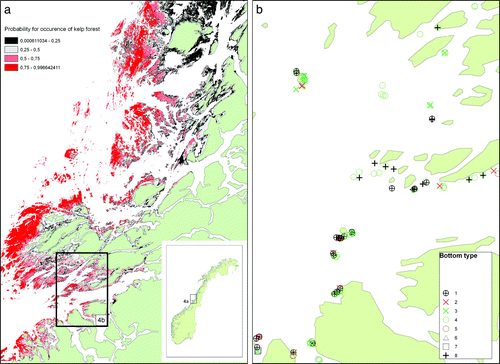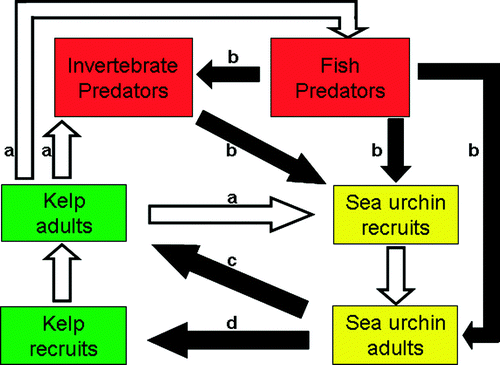Figures & data
Figure 1. Retreating sea urchins. Movement of the border between kelp-dominated areas and barren ground from 1980 until 2007. The barren ground area had its largest extent in 1980 where the border extended south to 63°30′ N (Sivertsen Citation1982). Røv et al. (Citation1990) showed that the border had moved to 63o40′ N by 1990 and in 2000 the border had at least moved to 64o10′ N (Sjøtun et al. Citation2001). In 2007 the border was situated at 65°30′ N (Norderhaug & Christie Citation2007).

Figure 2. Occurrence of kelp (Laminaria hyperborea) in relation to different variables. Columns show total number of registrations for different values of the variables depth, exposure (SWM), slope (SLOPE) and latitude (LAT, WGS84 UTM 33). Dark shading shows the registration of kelp and light shading no occurrence of kelp. Solid lines show the proportion of kelp registrations out of the total number of registrations.

Figure 3. Relative effects within the GAM model from the significantly important predictors (depth, wave exposure (SWM) and latitude (LAT, WGS84 UTM 33), Df) for the distribution of kelp (Laminaria hyperborea, solid line) with 95% C.I. (dotted lines).

Figure 4. Probability model for the distribution of kelp in the border area between barren grounds and areas dominated by kelp in 2007. In red areas there is a high probability for occurrence of kelp (Laminaria hyperborea), and in grey and black areas there is a low probability. White areas are outside the fundamental niche for kelp or outside the area of which the model can predict probabilities (e.g. in fjords). The spatial GIS model is predicted from statistical GAM models from the GRASP software (Lehman et al. Citation2002), with depth, wave exposure (according to the SWM fetch model: Isæus 2004) and latitude as predictors and kelp occurrence as the response variable. (b) Stations in a smaller area illustrating the mosaic of different bottom types just south of the kelp forest-barren ground border (marked with a rectangle in 2a). 1: Stations with scattered young Laminaria kelp being grazed by red sea urchins (Echinus esculentus). 2: Barren ground dominated by red sea urchins. 3: Barren ground dominated by green sea urchins (Strongylocentrotus droebachiensis). 4: Young, homogenous kelp (L. hyperborea) forest and few or no sea urchins. 5: Well-developed (old) kelp (L. hyperborea) forest and few sea urchins. 6: Laminaria digitata forest. 7: Laminaria saccharina forest. 8: Soft bottom.

Figure 5. Conceptual figure describing possibly important interactions (arrows) between kelp (Laminaria hyperborea), sea urchins (Strongylocentrotus droebachiensis) and potentially important predators. Black arrows indicate a negative effect and white arrows a positive effect. (a) Adult kelp provides a habitat for sea urchin recruits, invertebrate predators and a nursery area and habitat for fish. (b) Invertebrate and fish predators prey on sea urchin recruitment. (c) If sea urchins become abundant they aggregate and graze down the kelp forest. Then the kelp and associated predators are lost and only sea urchins survive. (d) When the kelp forest is lost, sea urchin populations prevent kelp from re-establishing by grazing.
